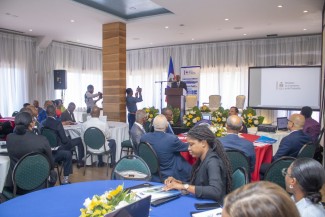Unsustainable use of the earth’s resources is a primary driver of the triple threat of pollution, biodiversity loss and climate change. The current linear model of production and consumption is also a significant driver of social injustice, with the majority of resource consumption and wealth accumulation occurring in the Global North, but the highest levels of environmental impact and threats to human health being experienced in the Global South. There is an urgent need to move away from an extractive, polluting, and unjust production–consumption system to one that decouples social and environmental prosperity from unsustainable resource use.
The circular economy offers a life cycle approach to tackling this problem across value chains. Rather than the current linear flow of materials through the global economy, in which they are extracted, processed, manufactured, used, and finally disposed of as waste, a circular economy uses a systemic approach to decouple economic prosperity from material use by maintaining a circular flow of resources through regenerating, retaining, or adding to their value, while contributing to sustainable development.
No country can achieve a circular economy on its own. Rather, all are dependent on international trade to secure affordable and reliable access to a wide range of different materials, goods and services. This includes the trade in circularity-enabling goods (such as remanufacturing and recycling equipment), services (circular design skills, leasing or rental services, and repair services), relevant intellectual property, affordable second-hand goods, secondary raw materials and waste and scrap that can be recovered for use in primary production. The combination of all of these types of trade flows can be considered as ‘circular trade’.
Circular trade flows have grown strongly in value over the past two decades. For example, the value of trade in second-hand goods, secondary raw materials, and waste for recovery rose by more than 230 per cent (from $94 billion to $313 billion) between 2000 and 2019, with the global export value of trade in goods rising by around 195 per cent over the same period.
Although circular trade is a key enabler of a global circular economy, a range of regulatory and technical challenges are inhibiting its advancement. These include a lack of mutually recognized definitions, classifications, interoperable standards, regulations, and conformity procedures. Furthermore, as an emerging area of activity, the circular economy has itself only been embedded to a limited degree in bilateral, regional and plurilateral trade and economic cooperation agreements. This restricts the scope and potential for collaboration around transboundary issues such as illegal waste, supply-chain transparency and traceability, investment, or the issues pertaining to mutual recognition, technical barriers to trade, and trade facilitation.
Global inequities in power relations, digital trade capabilities, trade infrastructure, access to circular finance, and industrial and innovation capabilities mean that countries in the Global North are better positioned than those in the Global South to reap the benefits of circular trade. If an explicit goal to reduce inequality is not built into the global circular economy transition, then it is highly likely that these inequities will create a ‘circularity trade divide’, in which the gains accrued from circular trade are highly unevenly distributed between developed and least developed countries.6
An alternative pathway for the circular transition should be pursued in which circular trade serves as an enabler of fair, inclusive and circular societies. Rather than the current fragmented and largely unilateral approach to transitioning to the circular economy, overcoming the barriers to circular trade requires a coordinated and collaborative global response to ensure that all countries and territories, in particular developing economies, benefit equally from the transition. To address these challenges, Chatham House, alongside an alliance of organizations spanning Africa, Southeast Asia, Latin America and the Caribbean, and Europe published a framework for inclusive circular trade.
The framework for inclusive trade is intended to enable a pathway in which circular trade helps to promote fair, inclusive, and circular societies. Crucially it outlines five areas for collective action. Firstly, the global community requires a shared language on various aspects of circular trade (such as shared definitions and classifications). A shared language underpins all other actions areas and is the most likely to be achieved in the short term. Second, participating in circular trade needs to be made easier through reducing certain Technical Barriers to Trade and improving trade facilitation measures. Finally, longer-term political commitment in terms of capacity building for low-income countries is necessary alongside the embedding of circular economy within trade and economic integration agreement.
The WTO Aid for Trade initiative could play an important role in helping address these five areas for action, in particular capacity building. This includes investing in critical infrastructure to enable domestic circular activities such as repairing, remanufacturing, and recycling which will help domestic industry maximise the value capture from imported circular trade flows (such as second-hand goods and secondary raw materials).
Investment in trade-related infrastructure is also necessary. An example includes the roll out of digital systems for circular trade governance such as those that enable electronic prior informed consent of waste shipments and supply chain traceability and transparency. A second example is funding the improvement of port and rail infrastructure improving trade efficiency and therefore competitiveness in the export and import of circular trade flows.
WTO Aid for Trade could also prioritise the capacity building of circular economy skills and education. This could include the training of enforcement agencies to be better able to identify and counter illegal waste shipments, or the training of industrial actors in necessary circular economy skills for conducting domestic circular activities (such as remanufacturing and repair) or policy making.
To achieve the above, circularity should be identified as a core pillar in the pursuit of ‘greening’ the WTO Aid for Trade initiative. In doing so, the Aid for Trade initiative could also become an important platform to encourage collaboration between donor and recipient countries on shared circular economy trade related opportunities and challenges going forward.
----
To learn more about Aid for Trade and the circular economy, register to the WTO Aid for Trade Global Review 27-29 July 2022.
If you would like to reuse any material published here, please let us know by sending an email to EIF Communications: eifcommunications@wto.org.



